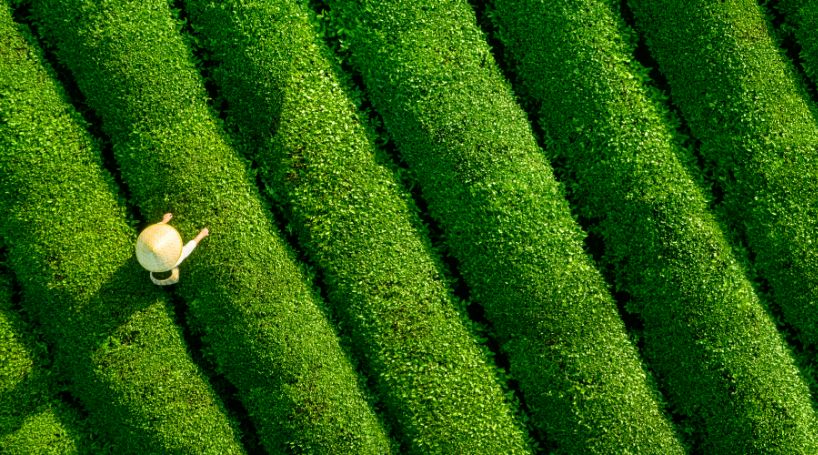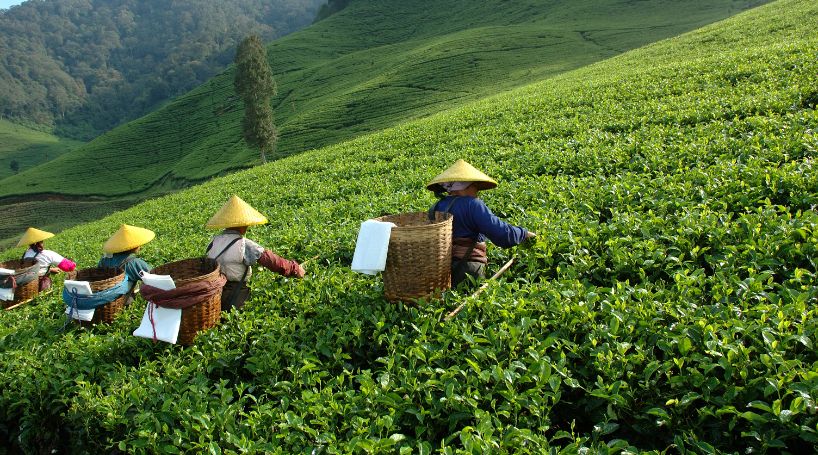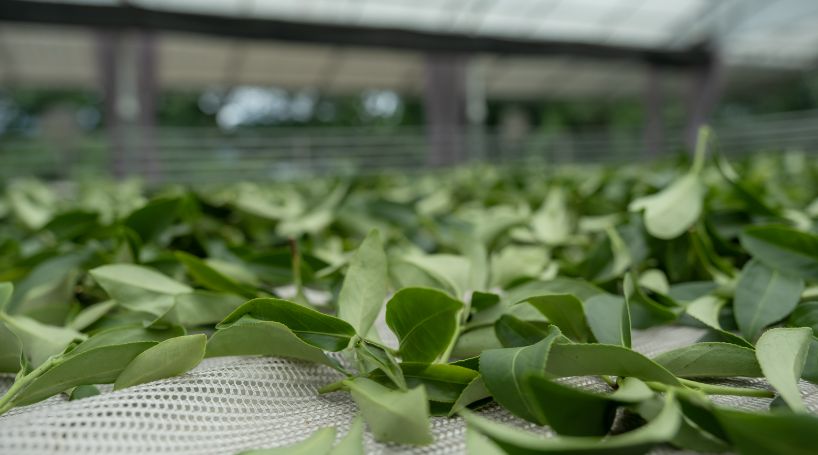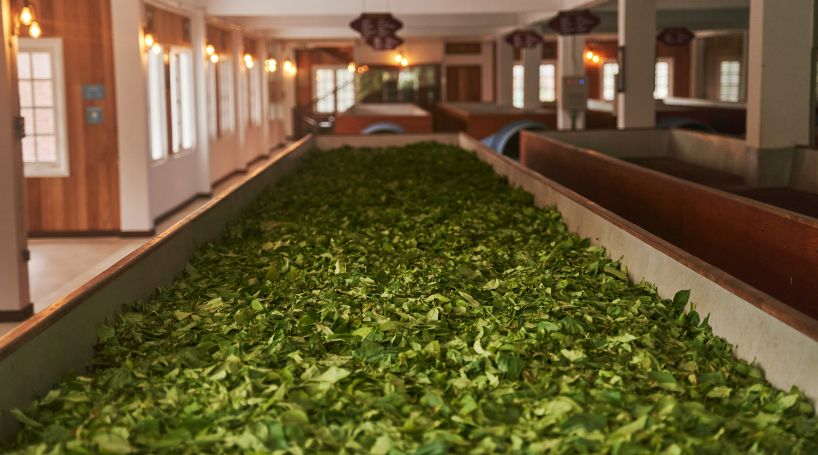
There is no doubt that tea is one of the most widely consumed beverages in the world.
Loose-leaf tea is enjoyed in every corner of the globe and it’s all thanks to the fact that it is produced using a unique and ingenious production process.
The process allows for tea production on a mass scale which means that it can be produced and shipped all over the world in a relatively quick time.
This then allows wholesale tea suppliers such as us to get more quality tasting tea to a wider audience.
In this post, we will dive into the full tea production process so you can get a deeper insight into what’s involved in creating high-quality great-tasting loose-leaf tea.
The Tea Production Process
Tea production is a complex process that involves several stages.
The details of these stages may vary depending on the type of tea (e.g., green tea, black tea, oolong tea), but the basic steps are generally similar.
Here’s a guide on the tea production process:
Growing
Tea is produced from tea leaves which come from a plant, therefore these plants need to be planted and cultivated in the beginning stages.
Tea is primarily produced from the leaves of the Camellia Sinensis plant and different varieties of this plant are cultivated for various types of tea.
Tea plants are typically grown in well-drained soil at higher altitudes, as the altitude can affect the flavour profile of the tea.
It’s not just the altitude that can affect the flavour but even the surrounding vegetation can have an effect on it also.
Camellia Sinensis Var. Assamica is another plant used in tea production.
This variety is known as the Assam tea plant and is native to the Assam region in India.
It has larger leaves and is commonly used to produce black tea.
Assamica plants are often found at lower elevations and are more tolerant of tropical climates.

Plucking
Tea plucking is a crucial step in the tea production process, as it determines the quality and characteristics of the final product.
The two main methods of plucking tea involve either hand plucking or mechanical harvesting.
The choice between these methods depends on factors such as the type of tea, the quality desired, and the scale of production.
Hand Plucking
Hand plucking is considered the traditional and highest-quality method.
Skilled workers, often referred to as “tea pluckers” or “pluckers,” carefully select the young and tender leaves along with the unopened leaf buds.
This is known as “two leaves and a bud,” and it is the most common method for harvesting high-quality tea.
In some cases, especially for premium teas, only the bud or a single leaf may be plucked.
This is known as fine plucking and is often associated with white and green tea production.
Hand plucking allows for precise control over which leaves are harvested, ensuring that only the highest-quality leaves are selected.
This method is labour-intensive and requires skilled workers, making it more expensive.
Mechanical Harvesting
Mechanical harvesting involves the use of machines to strip the leaves from the tea bushes.
These machines are equipped with rotating blades or shears that cut off the leaves. This method is quicker and more efficient than hand plucking but is less selective.
Some mechanical harvesters are designed to collect the entire shoot of the plant, including leaves and stems.
While this method is faster, it often results in lower-quality tea, as it may include older and tougher leaves.
Mechanical harvesting is commonly used in large-scale tea plantations where efficiency and cost-effectiveness are priorities.
However, it can lead to a mix of leaves at various stages of maturity, potentially affecting the flavour and quality of the tea.
Withering
Once the leaves are plucked it’s time for them to undergo the withering process.
The goal of this process is to reduce the moisture content within the leaf. The plucked leaves will usually be laid out on fabric or bamboo mats and left to wilt and wither.
These are placed inside a controlled temperature environment which the tea farmers can control with great precision.
This ensures that the tea leaves are exposed to the correct temperatures and humidity.
Each batch is monitored carefully to ensure their quality and they are carefully roasted so each leaf gets the same exposure.
During this process, the leaves will experience up to 50% moisture loss.

Rolling (Bruising)
The withered leaves are rolled to break the cell walls, releasing enzymes and initiating the oxidation process.
There are different methods of rolling depending on the tea type that you want.
Here’s how each major tea type is typically rolled:
- Black Tea – After withering, black tea leaves undergo a rolling process. The rolling can be done by hand or mechanically, and it helps to break down the cell walls and initiate oxidation. The leaves are then spread out for further oxidation before being fired or dried to stop the process.
- Oolong Tea – After withering, the leaves are rolled to release enzymes. The degree of oxidation can vary, resulting in a wide range of oolong tea flavours, from light and floral to dark and robust.
- White Tea – White tea is the least processed among the major tea types. After withering, the leaves may be lightly rolled or simply allowed to dry naturally. The minimal processing preserves the natural appearance and delicate flavours of the young leaves and buds.
Oxidation
Oxidation is when the tea leaves are exposed to the air (oxygen) and left to dry out and darken.
When oxidation takes place this will have a significant impact on the tea’s strength, aroma and flavour.
The length of time in which the tea leaves are left out will depend on the type of tea that is being processed.
For example, green tea will be minimally oxidised which is why the tea leaves still look green.
Black tea however will be left to oxidise for much longer, therefore the leaves will be darkened, resulting in a browny-black colour.
Oolong tea will be partially oxidised so these leaves can vary from green to grey to black.
Firing (Drying)
The oxidised leaves are exposed to heat to halt the oxidation process.
This can be done through methods such as:
- Pan frying – This is when the leaves are tossed in a pan and heated. The leaves are continually tossed until they are fully dry.
- Oven baking – This is when the leaves are set on perforated trays in an oven and hot air is circulated. The tea leaves start to dry through convection.
- Sun drying – Not as common as the other methods but this is when the tea leaves are left out to dry in the sun. They are usually put into bamboo baskets.

Sorting and Grading
Sorting the tea leaves involves separating the tea leaves based on different criteria.
Some of the common sorting parameters include:
- Size – Tea leaves are often sorted by size. Larger leaves may be considered higher grade in some teas. Larger leaves may be used for loose-leaf tea, while smaller particles may be used for tea bags.
- Colour – The colour of the leaves can indicate the level of oxidation or the presence of stems and other unwanted materials.
- Shape – The shape of the leaves can influence the appearance and quality of the tea.
- Consistency – Ensuring uniformity in the size and appearance of the leaves.
After sorting, tea leaves are graded based on quality. The grading system varies among different tea-producing regions and types of tea.
For example, in some regions, the highest-quality teas may be labelled as “orange pekoe,” while other grades may include terms like “broken orange pekoe” or “fannings.”
Packaging and Distribution
Now the tea is ready to be packaged and sent all over the world for consumption. There are various methods of packaging depending on who the customer is.
For customers who are selling directly to the consumer, they will have their tea leaves placed in smaller branded packaging. This may consist of tea tins, tea bags or small cardboard boxes.
For larger-scale distribution, the tea leaves will be placed in larger packaging such as plywood boxes or paper sacks.
Each packaging will be marked with the tea type and grade so that it is identifiable by the customer.
The packaged tea is then distributed to local and international markets for consumption.
Testing and Quality Control
Quality control experts may conduct tests to ensure that the tea meets the desired criteria.
During the quality assessment of tea, an examination of its physical attributes, such as colour, size, flavour, and taste, is conducted.
Comprehensive analyses are performed to detect the presence of chemicals, heavy metals, toxins, and other substances.
These evaluations adhere to established standards set by the official governing body of the country of origin.
High-Quality Processed Loose Leaf Tea
The process of creating tea leaves fit for consumption is a lengthy but delicate one.
Each stage plays its own unique part in creating some of the best-tasting tea on the market.
At Leaf Tea, we only deal with suppliers who trade the highest quality tea leaves.
By doing so we know that our buyers are receiving a world-class product that will leave a lasting impression on their customers.
We have a dedicated team that offers full training and support to all of our tea stockists.
Our training packages are bespoke and can be done online or in-person depending on the location of your premises.
Reach out to us today if you’re interested in becoming a stockist of our fine-tasting loose-leaf tea.





